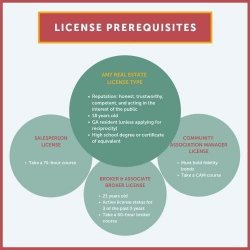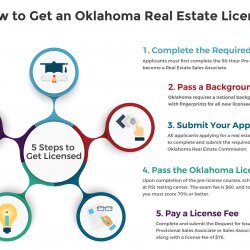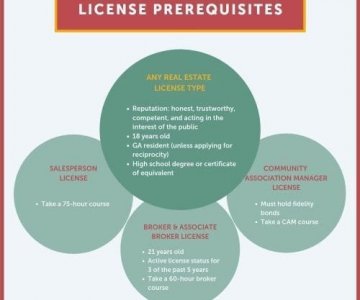the best guide to how to get your real estate license

The factor most lenders need a 20% deposit is because of equity. If you don't have high enough equity in the home, you're thought about a possible default liability. In simpler terms, you represent more danger to your lending institution when you do not spend for enough of the house. PMI is determined as a percentage of your initial loan amount and can range from 0. 3% to 1. 5% depending on your deposit and credit report. Once you reach a minimum of 20% equity, you can request to stop paying PMI.Homeowners association (HOA) costs are common when you buy a condo or a home that's part of a prepared neighborhood.
The costs cover common charges, such as neighborhood space maintenance (such as the yard, neighborhood swimming pool or other shared facilities) and building upkeep. When you're taking a look at homes, HOA fees are typically disclosed upfront, so you can see just how much the current owners pay per month or per year. HOA costs are an additional continuous fee to compete with, they don't cover real estate tax or house owners insurance coverage for the most part. Choose a long loan term, Buy a less costly home, Pay a bigger deposit, Find the most affordable interest rate offered to you, You can anticipate a smaller bill if you increase the variety of years you're paying the home loan.
For example, a 15-year home loan will have greater month-to-month payments than a 30-year mortgage, since you're paying the loan off in a compressed amount of time. An obvious but still essential path to a lower month-to-month payment is to buy a more budget-friendly house. The greater the house rate, the greater your regular monthly payments. This ties into PMI. If you don't have sufficient conserved for a 20% down payment, you're going to pay more each month to protect the loan. Buying a home for a lower cost or waiting until you have larger down payment cost savings are two methods to conserve you from bigger regular monthly payments.

You don't need to accept the very first terms you receive from a lender. Attempt shopping around with other loan providers to discover a lower rate and keep your regular monthly home mortgage payments as low as possible. If you have an FHA loan, the PMI sticks with you throughout the remainder of the loan. The only way to get out of it is to refinance, which is another procedure in and of itself. If you have a traditional loan, the PMI will burn off when you reach 20% LTV, however that will normally take 7-10 years. There are a few ways to leave paying PMI. Put 20% down Find a portfolio lender: Portfolio loan providers are those that keep their loans by themselves books. Simply put, they do not sell https://www.topratedlocal.com/wesley-financial-group-reviews their loans to Fannie or Freddie, so they are able to be more flexible.
What Is Arv In Real Estate Fundamentals Explained
While you may not pay PMI, your rate of interest may be greater, which might not eventually make a big influence on your month-to-month payment. 80/10/10 contract: Some loan providers will use an 80/10/10 arrangement. With this technique, you get your normal 80% loan that would prevent PMI completely (What does contingent in real estate mean). You then take out an additional loan for 10%, and then you just put 10% down yourself. This can be risky because that additional 10% loan might have insane terms, including balloon payments, adjustable interest rates, and so on. Take a look at this post to read more about PMI.
Home mortgage Insurance (likewise understood as home loan warranty and home-loan insurance coverage) is an insurance plan which compensates lending institutions or investors for losses due to the default of a home mortgage loan. Home mortgage insurance can be either public or private depending upon the insurer. The policy is also called a home loan indemnity assurance (MIG), especially in the UK. In Australia, debtors should pay Lenders Home mortgage Insurance coverage (LMI) for home mortgage over 80% of the purchase rate. [] In Singapore, it is mandatory for owners of HDB flats to have a mortgage insurance if they are using the balance in their Main Provident Fund (CPF) accounts to pay for the month-to-month installation on their home loan.

Private home loan insurance, or PMI, is generally required with a lot of conventional (non government backed) home loan programs when the down payment or equity position is less than 20% of the home worth. In other words, when acquiring or refinancing a house with a traditional mortgage, if the loan-to-value (LTV) is greater than 80% (or equivalently, the equity position is less than 20%), the debtor will likely be required to bring private home mortgage insurance. PMI rates can range from 0. 14% to 2. 24% of the primary balance each year based on percent of the loan guaranteed, LTV, a repaired or variable interest rate structure, and credit rating.
The majority of people pay PMI in 12 regular monthly installments as part of the home loan payment. In the United States, PMI payments by Click to find out more the borrower were tax-deductible until 2018. Borrower paid private mortgage insurance coverage, or BPMI, is the most typical kind of PMI in today's home loan lending marketplace. BPMI permits debtors to obtain a mortgage without having to offer 20% down payment, by covering the lending institution for the added risk of a high loan-to-value (LTV) mortgage. The United States Homeowners Security Act of 1998 permits customers to demand PMI cancellation when the quantity owed is minimized to a specific level. The Act needs cancellation of borrower-paid home mortgage insurance coverage when a particular date is reached.
The Best Strategy To Use For How To Get A Real Estate License In Florida
BPMI can, under certain circumstances, be cancelled earlier by the servicer ordering a new appraisal revealing that the loan balance is less than 80% of the home's value due to appreciation. This usually requires at least two years of on-time payments. How much does it cost to become a real estate agent. Each investor's LTV requirements for PMI cancellation vary based on the age of the loan and current or initial occupancy of the home. While the Act applies just to single family main residences at closing, the financiers Fannie Mae and Freddie Mac enable home mortgage servicers to follow the very same rules for secondary houses. Financial investment residential or commercial properties normally require lower LTVs.
Sometimes, the Lender is offering the borrower a credit to cover the cost of BPMI. Lending institution paid private home mortgage insurance, or LPMI, resembles BPMI other than that it is paid by the loan provider and built into the rate of interest of the home mortgage. LPMI is normally a function of loans that claim not to require Mortgage Insurance coverage for high LTV loans. The advantage of LPMI is that the overall monthly home loan payment is frequently lower than a similar loan with BPMI, but because it's developed into the rate of interest, a borrower can't get rid of it when the equity position reaches 20% without refinancing.
In mortgage insurance coverage, a master policy issued to a bank or other mortgage-holding entity (the policyholder) lays out the terms of the protection under insurance certificates. The certificates document the specific qualities and conditions of each specific loan. The master policy includes different conditions including exemptions (conditions for denying protection), conditions for notice of loans in default, and declares settlement. The legal provisions in the master policy have actually received increased scrutiny considering that the subprime home loan crisis in the United States. Master policies generally require prompt notification of default include arrangements on monthly reports, time to submit fit restrictions, arbitration agreements, and exemptions for neglect, misrepresentation, and other conditions such as pre-existing environmental impurities.
Protection can be rescinded if misstatement or fraud exists. In 2009, the United States District Court for the Central District of California identified that home mortgage insurance coverage might not be rescinded "poolwide". Mortgage insurance coverage began in the United States in the 1880s, and the first https://bestcompany.com/timeshare-cancellation/company/wesley-financial-group law on it was passed in New york city in 1904. The market grew in response to the 1920s realty bubble and was "completely bankrupted" after the Great Anxiety. By 1933, no personal home mortgage insurance companies existed.:15 The bankruptcy was connected to the market's participation in "home loan pools", an early practice similar to home loan securitization. The federal government started guaranteeing home loans in 1934 through the Federal Housing Administration and Veteran's Administration, but after the Great Anxiety no personal home loan insurance was licensed in the United States till 1956, when Wisconsin passed a law permitting the first post-Depression insurance provider, Home loan Warranty Insurance Corporation (MGIC), to be chartered.






Ingen kommentarer endnu